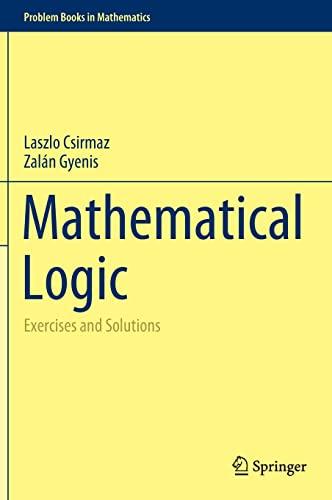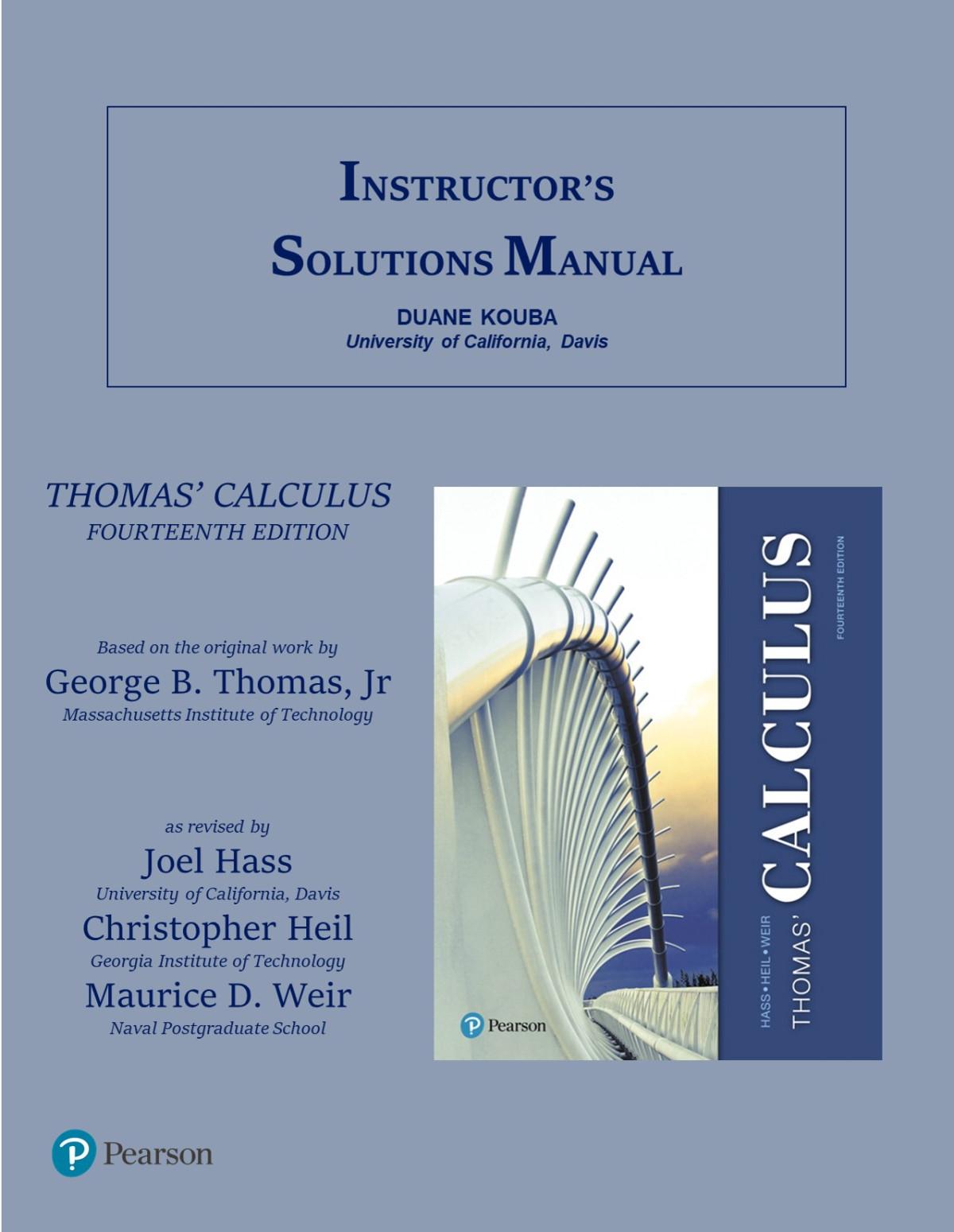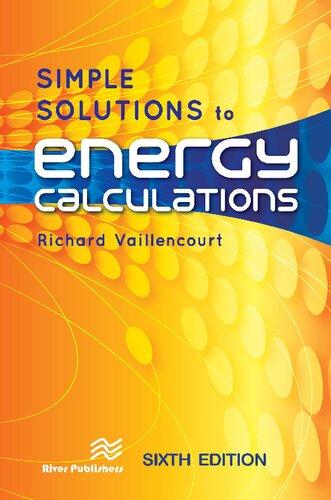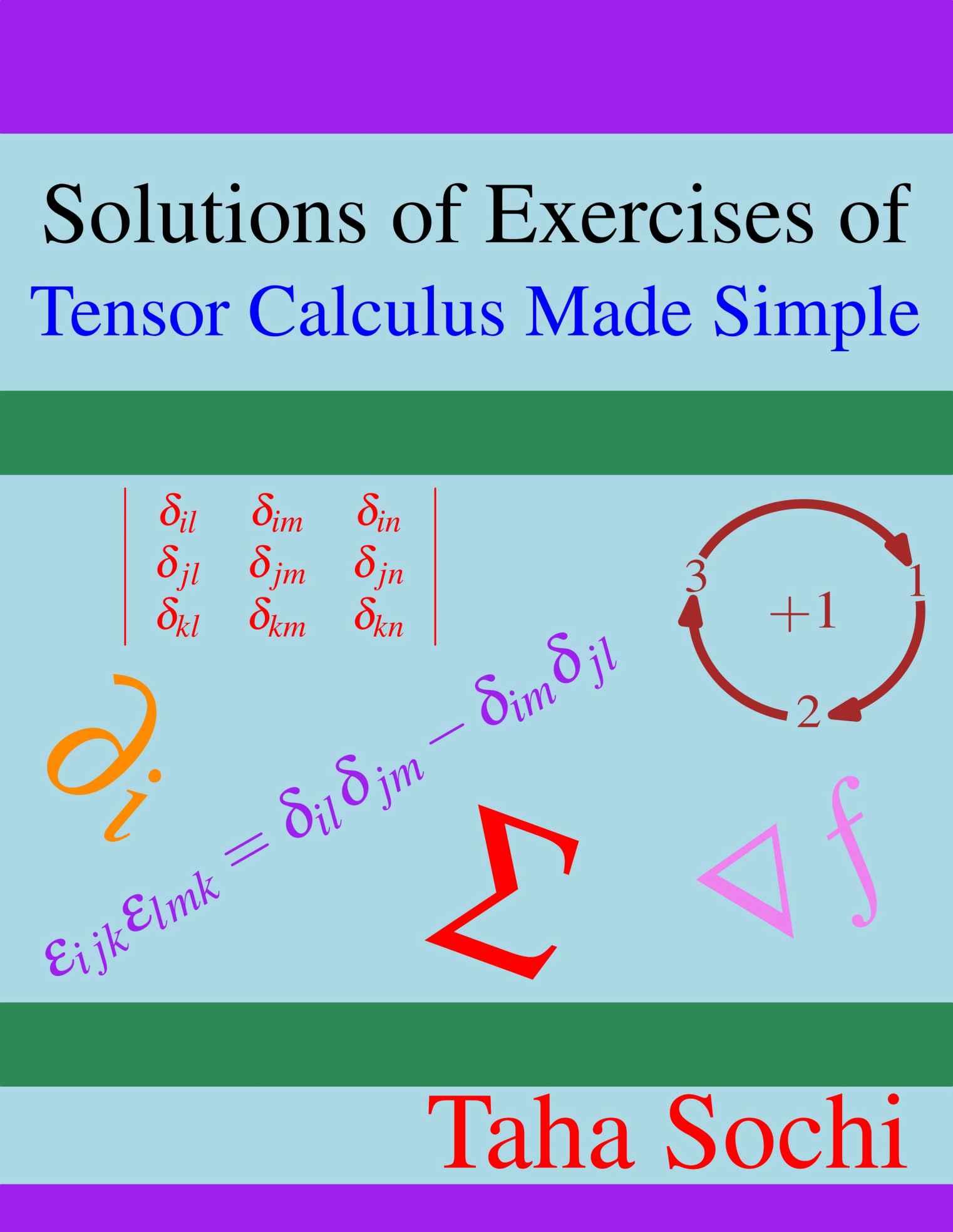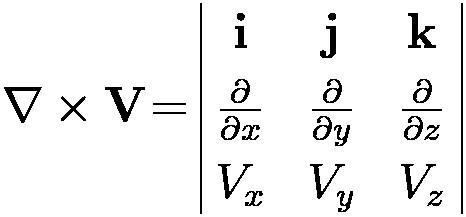Chapter 1
Preliminaries
Exercise 1. Name three mathematicians accredited for the development of tensor calculus. For each one of these mathematicians, give a mathematical technical term that bears his name.
Answer:
Mathematicians: Ricci, Levi-Civita and Christoffel.
Terms: Ricci calculus, Levi-Civita symbol, Christoffel symbols.
Exercise 2. What are the main scientific disciplines that employ the language and techniques of tensor calculus?
Answer:
Differential geometry, general theory of relativity, continuum mechanics, and fluid dynamics among other disciplines.
Exercise 3. Mention one cause for the widespread use of tensor calculus in science.
Answer:
Its ability to deal with complex problems in multi-dimensional spaces as it provides very efficient and powerful mathematical tools for modeling and analyzing this type of problems while complying with the principle of invariance.
Exercise 4. Describe some of the distinctive features of tensor calculus which contributed to its success and extensive use in mathematics, science and engineering.
Answer: Elegance, compactness, clarity, power, eloquence, etc.
Exercise 5. Give preliminary definitions of the following terms: scalar, vector, tensor, rank of tensor, and dyad.
Answer:
Scalar: mathematical object (e.g. number, variable, function) that is completely identified by its magnitude and sign with no reference to a basis vector set.
Vector: mathematical object that is completely identified by its magnitude and a single direction in space; hence it requires a basis vector set to be fully identified in component form.
Tensor: mathematical object that is completely identified by a set of components each of which is associated with multiple directions in space and hence it requires a basis tensor set (e.g. EiEj for rank-2).
Tensor is also used to describe some mathematical objects with certain transformation properties and hence it includes scalars and vectors.
Rank of tensor: a measure of the complexity of the structure of tensor; it is quantified by the number of free indices of the tensor.
Dyad: tensor object associated with double direction; outer product of two vectors such as E1 E3.
Exercise 6. What is the meaning of the following mathematical symbols?
Answer:
Partial derivative operator with respect to the ith coordinate. Laplacian operator in Cartesian form. nabla operator.
Partial derivative of scalar A with respect to the ith coordinate. Laplacian operator.
Covariant derivative of vector Ai (which is a rank-1 covariant tensor) with respect to the kth coordinate.
Exercise 7. Is the following equality correct? If so, is there any condition for this to hold?
∂k∂l = ∂l∂k
Answer:
Yes, it is correct assuming the C2 continuity condition.
Exercise 8. Pick five terms from the Index about partial derivative operators and their symbols as used in tensor calculus and explain each one of these terms giving some examples for their use.
Answer:
Comma: used as subscript to indicate partial differentiation with respect to the following index(es).
Examples:
f, i Ai , jk
Bij, k
Commutative: partial differential operators with respect to different variables are commutative assuming the C2 continuity condition.
Examples:
∂i∂jg = ∂j∂ig
∂k∂lCq = ∂l∂kCq
Curl: cross product of the nabla operator and a non-scalar tensor.
Examples:
∇ × A
∇ × B
Laplacian: operator representing consecutive application of spatial partial differentiation as represented by the nabla operator It may be described as the divergence of gradient. It is usually symbolized by ∇2 or Δ or ∂ii.
Examples:
B ∂jjAi
nabla: partial differential operator usually symbolized by ∇. It is vector operator. It is spatial operator as it stands for differentiation with respect to coordinates of space. It is used as a basis for a number of operators and operations in vector and tensor calculus such as gradient, divergence and curl.
Examples: ∇f ∇⋅A
Exercise 9. Describe, briefly, the following six coordinate systems outlining their main features: orthonormal Cartesian, cylindrical, plane polar, spherical, general curvilinear, and general orthogonal.
Answer:
Orthonormal Cartesian: rectilinear coordinate system with mutually orthogonal basis vectors each of unit length; usually represented in 3D space by (x, y, z) where each one of these variables represents signed distance from the origin of coordinates along the corresponding coordinate axis; the simplest and most commonly used of all coordinate systems; should be chosen if it satisfies the requirements for solving the given problem.
Plane polar: it is the same as the cylindrical system (refer to the next) with the absence of the third coordinate (i.e. z coordinate); hence it is 2D system used in coordinating plane surfaces; particularly useful for solving problems with circular symmetry and problems of rotational nature.
Cylindrical: curvilinear orthogonal coordinate system; it has unit basis vectors by definition; these vectors are coordinate dependent in their direction except the basis vector corresponding to the third coordinate which is constant; specifically defined for 3D spaces; particularly useful for solving problems with cylindrical symmetry; usually represented by (ρ, φ, z) where ρ represents the perpendicular positive distance from the given point in space to the third axis of the corresponding rectangular Cartesian system, φ represents the angle between the first axis and the line connecting the origin of
coordinates to the perpendicular projection of the point on the x1x2 plane of the corresponding Cartesian system, and z is the same as the third coordinate of the point in the reference Cartesian system.
Spherical: curvilinear orthogonal coordinate system; it has unit basis vectors by definition; all these vectors are coordinate dependent in their direction; specifically defined for 3D spaces; particularly useful for solving problems with spherical symmetry; usually represented by (r, θ, φ) where r represents the positive distance from the origin of coordinates to the given point in space, θ is the angle from the positive x3 axis of the corresponding Cartesian system to the line connecting the origin of coordinates to the point, and φ is as defined in the cylindrical system.
General curvilinear: it includes all types of curvilinear systems; its basis vectors are generally functions of position in space and hence they are coordinate dependent; its basis vectors are not necessarily of unit length or mutually perpendicular; its basis vectors can be covariant of tangential nature or contravariant of gradient nature.
General orthogonal: it can be rectilinear or curvilinear; its characteristic feature is that its basis vectors (whether covariant or contravariant) are mutually perpendicular at each point of the space where the system is defined.
Exercise 10. Which of the six coordinate systems in the previous exercise are orthogonal?
Answer:
All, except general curvilinear which can be orthogonal or not.
Exercise 11. What “basis vectors” of a coordinate system means and what purpose they serve?
Answer:
Basis vectors are a set of rank-1 tensors that associates a given coordinate system where non-scalar tensors are identified in reference to that set. Basis vectors can be either of covariant type representing tangents to coordinate curves (i.e. curves of constant coordinates except one) or of contravariant type representing gradients of coordinate surfaces (i.e. surfaces of variable coordinates except one). A coordinate system in nD space requires exactly n mutually independent basis vectors to be fully and unambiguously
represented. The main purpose of the basis vectors is to identify non-scalar tensors in component form. Basis vectors are also used in the definition and formulation of other mathematical objects such as metric tensor.
Exercise 12. Which of the six coordinate systems mentioned in the previous exercises have constant basis vectors (i.e. some or all of their basis vectors are constant both in magnitude and in direction)?
Answer:
Orthonormal Cartesian whose all basis vectors are constant in magnitude and direction.
Cylindrical whose z basis vector is constant in magnitude and direction.
Exercise 13. Which of the above six coordinate systems have unit basis vectors by definition or convention?
Answer:
All except general curvilinear and general orthogonal.
Exercise 14. Explain the meaning of the coordinates in the cylindrical and spherical systems (i.e. ρ, φ and z for the cylindrical, and r, θ and φ for the spherical).
Answer:
Cylindrical: ρ represents the perpendicular positive distance from the given point in space to the third axis of the corresponding rectangular Cartesian system, φ represents the angle between the first axis of the corresponding Cartesian system and the line connecting the origin of coordinates to the perpendicular projection of the point on the x1x2 plane of the corresponding Cartesian system, and z is the same as the third coordinate of the point in the reference Cartesian system.
Spherical: r represents the positive distance from the origin of coordinates to the given point in space, θ is the angle from the positive x3 axis of the corresponding Cartesian system to the line connecting the origin of coordinates to the point, and φ is as defined in the cylindrical system.
Exercise 15. What is the relation between the cylindrical and plane polar coordinate systems?
Answer:
Plane polar coordinate system is a cylindrical system with no z dimension and hence it is a 2D system with ρ and φ coordinates only.
Exercise 16. Is there any common coordinates between the above six coordinate systems? If so, what? Investigate this thoroughly by comparing each pair of these systems.
Answer:
Cartesian and cylindrical have common z coordinate. Plane polar and cylindrical have common ρ and φ coordinates. Plane polar and spherical have common φ coordinate. Cylindrical and spherical have common φ coordinate. No common coordinate between the other pairs although there may be accidentally.
Exercise 17. Write the transformation equations between the following coordinate systems in both directions: Cartesian and cylindrical, and Cartesian and spherical.
Answer:
Cartesian to cylindrical:
ρ = √(x2 + y2)
φ = arctan(y ⁄ x)
z = z
Cylindrical to Cartesian:
x = ρcosφ
y = ρsinφ
z = z
Cartesian to spherical:
r = √(x2 + y2 + z2)
θ = arccos(z ⁄ √(x2 + y2 + z2))
φ = arctan(y ⁄ x)
Spherical to Cartesian:
x = rsinθcosφ
y = rsinθsinφ
z = rcosθ
Exercise 18. Make a sketch representing a spherical coordinate system, with its basis vectors, superimposed on a rectangular Cartesian system in a standard position.
Answer:
A sketch should look like Figure 1↓.
1
Figure
Spherical coordinate system.
Exercise 19. What are the geometric and algebraic definitions of the dot product of two vectors? What is the interpretation of the geometric definition?
Answer:
Geometric definition: dot product of two vectors is the signed projection of one vector onto the other vector times the length of the other vector, that is:
a⋅b = |a| |b| cosθ
It can also be defined as the product of the lengths of the two vectors times the cosine of the angle between them. Both these forms of the geometric definition are represented by the above equation although the latter may be easier to grab from the equation.
Algebraic definition: dot product of two vectors is the sum of the products of the corresponding components of the two vectors, that is:
a⋅b = aibi
with summation over i Interpretation of geometric definition: as given above by either of the two forms assuming that the definition is stated by the other form.
Exercise 20. What are the geometric and algebraic definitions of the cross product of two vectors? What is the interpretation of the geometric definition?
Answer:
Geometric definition: a vector whose length is equal to the area of the parallelogram defined by the two vectors as its two main sides when their tails coincide and whose orientation is perpendicular to the plane of the parallelogram with a direction defined by the right hand rule, that is:
a × b = (|a||b|sinθ)n where 0 ≤ θ ≤ π is the angle between the two vectors when their tails coincide and n is a unit vector perpendicular to the plane containing a and b and is directed according to the right hand rule.
Algebraic definition: a vector represented by the following determinantal form where the determinant (which is not really determinant in strict technical sense) is expanded along its first row, that is:
Interpretation of geometric definition: as stated in the geometric definition prior to the equation.
Exercise 21. What is the dot product of the vectors A and B if A = (1.9, − 6.3, 0) and B = ( − 4, − 0.34, 11.9)?
Answer: A⋅B = (1.9)( − 4) + ( − 6.3)( − 0.34) + (0)(11.9) = − 5.458
Exercise 22. What is the cross product of the vectors in the previous exercise? Write this cross product in its determinantal form and expand it.
Answer:
Exercise 23. Define the scalar triple product operation of three vectors geometrically and algebraically.
Answer:
Geometric definition: the scalar triple product of three vectors a, b and c is a scalar defined by:
a⋅(b × c) = |a||b||c|sinφcosθ where φ is the angle between b and c while θ is the angle between a and b × c.
Algebraic definition: the scalar triple product is defined as the determinant of the array formed by the components of the three vectors as its rows or columns in the given order, that is:
Exercise 24. What is the geometric interpretation of the scalar triple product? What is the condition for this product to be zero?
Answer:
The geometric interpretation of the scalar triple product is that its magnitude is equal to the volume of the parallelepiped whose three main sides are the three vectors while its sign is positive or negative depending on whether the vectors form a right-handed or left-handed system. It is zero when the three vectors are coplanar (including collinear) since the volume is zero in this case.
Exercise 25. Is it necessary to use parentheses in the writing of scalar triple products and why? Is it possible to interchange the dot and cross symbols in the product?
Answer:
It is not necessary to use parentheses since cross product with scalar is not defined and hence a⋅b × c for example necessarily means a⋅(b × c) since (a⋅b) × c is meaningless; however parenthesis may be used for more clarity especially in introductory texts where the readers may not be sufficiently familiar with the notations and rules as well as similar reasons.
Yes, it is possible to interchange the dot and cross symbols, hence
a⋅(b × c) = (a × b)⋅c.
Exercise 26. Calculate the following scalar triple products:
a⋅(b × c)
a⋅(d × c)
d⋅(c × b)
a⋅(c × b)
(a × b)⋅c where
a = (7, − 0.4, 9.5)
b = ( − 12.9, − 11.7, 3.1)
c = (2.4, 22.7, − 6.9) and
d = ( − 56.4, 29.5, 33.8).
Note that some of these products may be found directly from other products with no need for detailed calculations.
Answer:
a⋅(c × b) = det(a, c, b) = − det(a, b, c) = 2409.977
(a × b)⋅c = a⋅(b × c) = − 2409.977
Exercise 27. Write the twelve possibilities of the scalar triple product of three vectors a, b and c and divide them into two sets where the entries in each set are equal. What is the relation between the two sets?
Answer:
1st set: a⋅(b × c), c⋅(a × b), b⋅(c × a), (a × b)⋅c, (c × a)⋅b, (b × c)⋅a.
2nd set: a⋅(c × b), c⋅(b × a), b⋅(a × c), (b × a)⋅c, (a × c)⋅b, (c × b)⋅a.
The two sets are opposite in sign but identical in absolute value.
Exercise 28. What is the vector triple product of three vectors in mathematical terms? Is it scalar or vector? Is it associative?
Answer:
The vector triple product of three vectors a, b and c is defined mathematically by:
a × (b × c) or
(a × b) × c
It is vector.
It is not associative, that is:
a × (b × c) ≠ (a × b) × c
Exercise 29. Give the mathematical expression for the nabla ∇ differential operator in Cartesian systems.
Answer:
∇i = ∂ ⁄ ∂xi = ∂i or ∇ = ei(∂ ⁄ ∂xi)
For 3D Cartesian systems, it is commonly given in vector notation by:
∇ = i(∂ ⁄ ∂x) + j(∂ ⁄ ∂y) + k(∂ ⁄ ∂z)
Exercise 30. State the mathematical definition of the gradient of a scalar field f in Cartesian coordinates. Is it scalar or vector?
Answer: ∂f ⁄ ∂xi = ∂if or
∇ = ei(∂f ⁄ ∂xi)
For 3D Cartesian systems, it is commonly given in vector notation by:
∇f = i(∂f ⁄ ∂x) + j(∂f ⁄ ∂y) + k(∂f ⁄ ∂z)
It is vector.
Exercise 31. Is the gradient operation commutative, associative or distributive? Express these properties mathematically.
Answer:
Not commutative, not associative but distributive, that is:
∇f ≠ f∇
(∇f)h ≠ ∇(fh)
∇(f + h) = ∇f + ∇h
Exercise 32. What is the relation between the gradient of a scalar field f and the surfaces of constant f? Make a simple sketch to illustrate this relation.
Answer:
The gradient vector is perpendicular to the surfaces of constant f A sketch should look like Figure 2↓
Figure 2 Gradient of scalar field.
Exercise 33. Define, mathematically, the divergence of a vector field V in Cartesian coordinates. Is it scalar or vector?
Answer:
The divergence of a vector field V in a 3D Cartesian system is:
∇⋅V = (∂Vx ⁄ ∂x) + (∂Vy ⁄ ∂y) + (∂Vz ⁄ ∂z)
It is scalar.
Exercise 34. Define “solenoidal” vector field descriptively and mathematically.
Answer:
A vector field a is solenoidal iff its divergence vanishes identically, that is: ∇⋅a = 0 throughout the region of space over which it is defined.
Exercise 35. What is the physical significance of the divergence of a vector field?
Answer:
It quantifies the convergence or divergence of the field over its domain of definition.
Exercise 36. Is the divergence operation commutative, associative or distributive? Give your answer in words and in mathematical forms.
Not commutative, not associative but distributive, that is: ∇⋅A ≠ A⋅∇
(fA) ≠ ∇f⋅A
∇⋅(A + B) = ∇⋅A + ∇⋅B
Exercise 37. Define the curl of a vector field V in Cartesian coordinates using the determinantal and the expanded forms with full explanation of all the symbols involved. Is the curl scalar or vector?
Answer:
Determinantal form:
Expanded form:
Symbols: ∇ nabla operator. × cross product operator. i, j, k basis vectors of orthonormal Cartesian 3D system. ∂ partial differentiation symbol. Vx, Vy, Vz components of V.
The curl is vector
Exercise 38. What is the physical significance of the curl of a vector field?
Answer: It quantifies the circulation of the field over its domain of definition.
Exercise 39. What is the technical term used to describe a vector field whose curl vanishes identically?
Answer: Irrotational.
Exercise 40. Is the curl operation commutative, associative or distributive? Express these properties symbolically.
Answer: Not commutative, not associative but distributive, that is:
∇ × A ≠ A × ∇
∇ × (A × B) ≠ (∇ × A) × B
∇ × (A + B) = ∇ × A + ∇ × B
Exercise 41. Describe, in words, the Laplacian operator ∇2 and how it is obtained. What are the other symbols used to denote it?
Answer:
It is the divergence of the gradient operator, and hence it is obtained by the following operation:
∇2 = ∇⋅∇ where ∇⋅ means taking the divergence of the gradient operator which is represented by the second ∇.
Examples of other symbols are:
Exercise 42. Give the mathematical expression of the Laplacian operator in Cartesian systems. Using this mathematical expression, explain why the Laplacian is a scalar rather than a vector operator?
Answer: ∇2 = (∂2 ⁄ ∂x2) + (∂2 ⁄ ∂y2) + (∂2 ⁄ ∂z2)
As we see, the basis vectors i, j, k are not present in the expression on the right hand side and hence the Laplacian is a scalar operator.
Exercise 43. Can the Laplacian operator act on rank-0, rank-1 and rank-n (n > 1) tensor fields? If so, what is the rank of the resulting field in each case?
Answer:
Yes, it can.
The Laplacian does not change the rank of the tensor that it acts upon and hence the tensors resulting from applying the Laplacian to the above fields will be of rank-0, rank-1 and rank-n respectively.
Exercise 44. Collect from the Index all the terms related to the nabla based differential operations and classify them according to each one of these operations.
Answer:
Some of these terms with their classification are:
(a) Gradient, vector operator, contravariant basis vector
(b) Divergence, solenoidal, divergence theorem, convergence and divergence of field.
(c) Curl, irrotational, Stokes theorem.
(d) Laplacian, scalar operator, harmonic operator.
Exercise 45. Write down the mathematical expression for the divergence theorem, defining all the symbols involved, and explain the meaning of this theorem in words.
Answer:
Symbols: A is differentiable vector field, V is finite bounded region in space, S is surface enclosing V, dτ is infinitesimal volume element, dσ is infinitesimal area element, n is unit vector normal to surface, ∭ and ∬ are symbols for volume and surface integrals in






